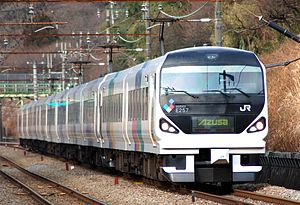E257-500 series
| E257 series | |
|---|---|

An E257 series train on a Chūō Line Azusa service, January 2008
|
|
| In service | 2001–Present |
| Manufacturer | Hitachi, Kinki Sharyo, Tokyu Car Corporation |
| Family name | A-train |
| Number built | 249 vehicles |
| Number in service | 249 vehicles |
| Formation | 2/5/9 cars per trainset |
| Operator(s) | JR East |
| Depot(s) | Matsumoto, Makuhari |
| Line(s) served | Chūō Main Line, Uchibō Line, Sotobō Line |
| Specifications | |
| Car length | 21,000 mm (68 ft 11 in) (end cars) 20,500 mm (67 ft 3 in) (intermediate cars) |
| Maximum speed | 130 km/h (80 mph) |
| Electric system(s) | 1,500 V DC overhead |
| Braking system(s) | Regenerative brake, electronically controlled pneumatic brakes, snow-resistant brake |
| Safety system(s) | ATS-SN, ATS-P |
| Track gauge | 1,067 mm (3 ft 6 in) |
The E257 series (E257系?) is a DC electric multiple unit (EMU) train type operated in Japan by East Japan Railway Company (JR East) and built jointly by Hitachi, Kinki Sharyo, and Tokyu Car Corporation.
Two variants exist: the original E257-0 series for use on Chūō Main Line Azusa and Kaiji limited-express services, and the E257-500 series for use on Uchibō Line, Sotobō Line, Sōbu Main Line, Narita Line, and Kashima Line limited-express services.
This sub-series version was introduced on 1 December 2001, to replace the aging 183 and 189 series rolling stock on Chuo Main Line Azusa and Kaiji services. Based at Matsumoto depot, the fleet consists of sixteen 9-car sets (M101 to M116) with a full cab at the Matsumoto end and a gangwayed cab at the Tokyo end, and five 2-car "add-on" sets (M201 to M205) with a full cab at the Tokyo end and a shunting cab only at the Matsumoto end.
The type was the recipient of the 45th Blue Ribbon Award (2002) of the Japan Railfan Club.
Matsumoto-based E257 series trains were also used on the Ohayō Liner Shinjuku and Home Liner Odawara commuter services running on the Tokaido Main Line until 14 March 2008.
...
Wikipedia
